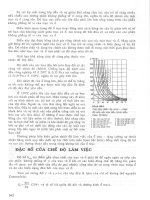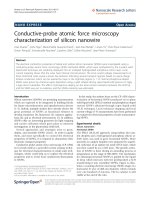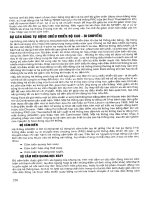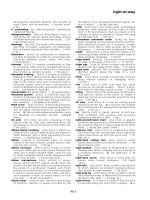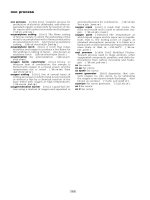Atomic Force Microscopy Episode 2 Part 7 pptx
Bạn đang xem bản rút gọn của tài liệu. Xem và tải ngay bản đầy đủ của tài liệu tại đây (658.77 KB, 20 trang )
328 Grimaldi et al.
border of the cells, anchoring structures named pseudopodia that are, similarly
to microvilli, involved in cell migration.
Cells exposed for 9 h (Fig. 1B and 2B) to MF show clear differences com-
pared to untreated cells: in this case, the microvilli have almost completely
disappeared from the surface of the cells and also pseudopodia are hardly
detectable.
Fig. 1. Constant force AFM images of untreated (A, 10 × 10 µm) and, respectively,
9 h (B, 13 × 13 µm), 24 h (C, 14 × 14 µm), and 64 h (D, 13 × 13 µm)-exposed Raji cells.
The gray scale is defined so that lighter colors correspond to higher corrugations. It is
worth noting that the top height reported for the cells progressively decreases at
increasing exposure. In (A), microvilli are visible as a lighter spot on the cell mem-
brane that are no more recognizable after 9–15 h (B). At very long exposure the cell
surface become characterized by several “furrows” and infolding (D). A cross-section
of these cells, taken along the white line A–A’, is shown in Fig. 4.
Lymphoblastoid Cells and Low-Frequency Magnetic Fields 329
3.2. Cell Membrane Features
The cell membrane, which because of the microvilli could not be directly
observed in untreated samples, appears quite smooth with no structures or pro-
trusions on the surface. In cells exposed for 15 h to MF (not shown) both
microvilli and pseudopodia can no longer be recognized whereas, as in samples
Fig. 2. Lateral friction AFM images of the same cells shown in Figs. 1A–D, respec-
tively. Lateral friction images (collected simultaneously to topography) are very sen-
sitive to small structures protruding from a large and corrugated surface so that they
are very suitable for describing microvilli (A), as well as the fine surface modifica-
tions induced by MF exposure (for instance the pits structure in D).
330 Grimaldi et al.
exposed for a shorter time, the dome shape is essentially unchanged. After 24 h
of exposure to MF (Figs. 1C and 2C), a slow membrane change is still going
on as revealed by the presence, in some cases, of ripples on the surface (better
recognized in the lateral friction image) and by a progressive flattening of the
cells. Such a membrane modification is accompanied, in cells exposed for 44 h,
by the appearance of “furrows” and pit-like structures (narrow membrane
infolding) that become more common in lymphoblasts exposed for 64 h to the
field (Figs. 1D and 2D). These features could be considered as markers of
the long exposure effect. After 64 h of exposure another important change in
cell structure, namely the loss of the spherical shape of the cell, becomes evi-
dent. It is worth noting that, in some cases, this change can already be found
after 44 h of exposure.
The noticeable modifications of the membrane surface because of MF expo-
sure are shown in the high resolution (3 × 3 µm) 3D images of Fig. 3, in which
the surface of an unexposed cell is compared with that of cells exposed for 9,
44, or 64 h. A comparison between Fig. 3A and 3B clarifies the effect of short
time exposure, which essentially results in the loss of microvilli.
3.3. Microvilli and Adhesion
An interesting question regards the possibility that the magnetic field expo-
sure changes the proportion of cells adhering to the substrate through the dis-
appearance of microvilli that are involved in cell adhesion and migration: we
did not find changes in adhesion although it is not possible to completely
exclude such an effect.
3.4. Surface Modification Analysis
The surface modifications after longer exposure are shown in Figs. 3C and
3D, consisting in a slow “aging” of the membrane, which becomes progres-
sively more ruffled and characterized by several narrow introflections easily
recognizable in samples exposed for 44 and 64 h.
Figure 4 shows the profiles, taken along the white lines drawn in Fig. 1, of
the four cells shown in Figs. 1 and 2. These data allow at least two important
observations about the overall morphological changes of the cells. The first
one is the progressive and relevant decrease in the maximum height of the cell
with increasing exposure. During the first 9–15 h, such a decrease can be related
to the observed loss of microvilli, but the residual changes must reflect modifi-
cations of other cellular structures. The second observation regards the cell’s
domed shape. In fact, unexposed or briefly exposed cells have high dome
(Fig. 4A and B), whereas a loss of the spherical shape starts to be detectable
after about 44 h (data not shown) and reaches a maximum after 64 h of expo-
sure. Observing the profile reported in Fig. 4D, it is quite evident how this loss
Lymphoblastoid Cells and Low-Frequency Magnetic Fields 331
of spherical shape is the result of a weakening of the support exerted by the cytosk-
eleton, the cellular structure responsible for the maintenance of the cell shape.
Fig. 3. Constant force images (4 × 4 µm) in a side view 3D representation of the
membrane surface of an untreated cell (A), after 9 h (B), 48 h (C) and 64 h (D) of
exposure to MF. The noise in these images is 0.1–0.3 nm. Microvilli are clearly visible
in the untreated sample, whereas after 9 h exposure the surface shows flat and smooth.
The progressive membrane ageing revealed by surface rippling and the appearance of
pit-like structures is evident in images (C) and (D).
332 Grimaldi et al.
It seems important to comment the possibility that drying might affect
differently the surface structure of control and treated cells: the control cells
were treated in exactly the same way as the exposed samples (except, of course,
for the exposure). In this way, any difference after drying could only be caused
by the exposure. A slightly higher, drying-induced, ruffling of the membrane
in cells exposed for 44 or 64 h to MF cannot be excluded because of the changes
in the cytoskeleton in those cells. However, we believe that this effect also, if it
exists at all, has to be ascribed to the MF-induced modification of the cytoskel-
eton and not to the drying procedure.
3.5. Artifacts
Another point regards the possibility that while fixing and drying samples
many changes might occur in the cell membrane: in the present study, we
prepared air-dried samples with a weakly stressing method in order to reduce,
as much as possible, any morphological artifact or effect on cell viability. Of
course it would be better to study the living cells with the AFM, even though
we consider that important information can also be obtained on dried samples.
For instance, on dried neurones, there are many aspects that have been studied
with ultra-high-vacuum techniques such as spectromicroscopy with synchro-
tron radiation (see, for instance, refs. 40 and 41).
Fig. 4. Cross-sections of the four cells presented in Fig. 1A–D, respectively (the
profiles are taken along the white line A–A’). This picture clearly shows the main
morphological modifications induced by MF. They consist in the (maximum) cell
height decreasing at increasing exposure as well as in the loss of cell shape taking
place after long time exposure (D). The decrease in height is about complete after 24 h
whereas the spherical shape is essentially conserved. At longer exposure, the residual
modifications affect only the domed shape of the cell (D). A comparison of the cross-
sections of (C) and (D) shows clearly that the loss of the dome shape arises from loss
of support exerted by the cytoskeleton, that is, from a breakdown of this structure.
Lymphoblastoid Cells and Low-Frequency Magnetic Fields 333
3.6. Quantitative Evaluation
To allow a more quantitative evaluation of the MF-induced effects, we per-
formed a statistical analysis of the relation between cell modification and
exposure time. The results, in terms of mean cell height and normalized rough-
ness (defined as the ratio between the height variance and the mean height
value on the portion of surface analyzed), are shown in Fig. 5A and B. During
the first 15–24 h, in which the main part of the MF-induced effect takes place,
both graphs show similar decreasing trends. The similarity between the trends
in this time frame also implies that the two phenomena of decrease in cell
height and loss of structure of the membrane surface occur simultaneously. At
longer exposure times, however, the trends of mean height and normalized
roughness differ. The height decrease continues, although very weakly, while
Fig. 5. Normalized roughness (B) and mean cell height (A) plotted as function of
exposure time. Each point is the average of about 50 cells. In both graphs the square
symbols represent the control samples and the circles refers to the exposed cells. The
controls only show variations within the experimental error. In (A), we report (solid
line) the fit executed on the last four data points (the ones free from effects on
microvilli). The best fit was obtained with the function y = m1 + m2 × e
–t/18
with the
following parameters: m1 = 1.20; m2 = 0.84; ∆m1 = 0.06; ∆m2 = 0.03. The extrapo-
lated value of H0 (the zero exposure cells height that does not take into account the
microvilli) is 2.04 µm. The results of the fit are discussed in the text.
Concerning cell height and roughness, the results indicate that during the first 24 h
both trends are very similar and give rise to a fast and large decrease of the parameters.
We suggest that these changes are characterized by two simultaneous effects of MF on
microvilli and cytoskeleton respectively. During the following 49 h, the trends become
different: in fact decrease in height continues, although very weakly, while the nor-
malized cell roughness undergoes a small increase in agreement with the progressive
rippling and appearance of pit structures on the membrane surface.
334 Grimaldi et al.
the roughness, after reaching a minimum value, shows a small but significant
increase. This behavior is not surprising compared with the morphological data
of Fig. 3, which, in fact, suggest a small increase of the roughness after long
exposure in agreement with the progressive membrane rippling and formation
of pit structures. This observation demonstrates the sensitivity of our statistical
analysis to fine morphological modifications.
In the graph of cell height two different rates of variation are recognizable: a
faster one during the first 15 h and a slower one after longer exposure. Because
the height decrease continues even after the disappearance of microvilli, an
important but time-limited phenomenon, it is clear that the MF acts also on
other cellular structure. This structure is the cytoskeleton, subject to a slow but
continuous modification. During the first 15 h, the superposition of these two
effects causes the faster rate of height variation that is one of the most impor-
tant results reported.
To avoid the possible interpretation that the data results from a decrease in
cell volume, we measured the (apparent) cellular volume individually using an
approximation of the cells as spheres or hyperboloids. The results (not shown)
reveal volume changes within the experimental error, which means that as
height decreases the cells become progressively wider at increasing exposure.
3.7. Role of Calcium
An interpretation of the effects we observed brings into play the role of
calcium. Microvilli and pseudopodia are in fact dynamic structures, mainly
composed of poly-actin filaments, that can be rapidly created and destroyed
(46) because of Ca
2+
concentration fluctuations that are known to be induced
by exposure to MF (3,4,21,22). Because actin is present both in the microvilli
and in the rest of the cytoskeleton, it is reasonable to believe that the cytoskel-
eton undergoes the same depolymerization effect observed in the microvilli.
However, in the case of the cytoskeleton, the effect is expected to be smaller
because of the rigidity of this structure, and it can be unequivocally identified
only after long MF exposure (i.e., when the microvilli have already disap-
peared).
3.8. Estimation of the Effect Induced by MF on the Cytoskeleton
A possible, although rough, estimate of the effect induced by MF on the
cytoskeleton during the first 15 h may be attempted by fitting the last four
points of the height curve, which are the ones completely free from effects on
microvilli. The result of the proposed fit, performed with a simple mono-expo-
nential function (Fig. 5A and its caption) show the two rates of the phenom-
enon. In fact, the best fit obtained, which does not take into account the
microvilli, describes very well the range of 13–64 h (for construction) but
Lymphoblastoid Cells and Low-Frequency Magnetic Fields 335
clearly indicates a rate of height variation slower than the experimental one in
the first hours of exposure. The difference between these two rates of height
variation can be ascribed (in large part, at least) to the effect on microvilli.
The use of the fit also allows extrapolation of a zero exposure height value
(H0) that takes into account only the effect on the cytoskeleton. The total height
variation during the first 9–15 h of exposure can be written as follows:
∆H
tot
= ∆H
c
+ ∆H
m
(1)
where ∆H
tot
is the total height variation; ∆H
c
is the contribution to the height
variation because of the cytoskeleton and ∆H
m
is the contribution to the height
variation attributable to the microvilli.
At t = 0 ∆H
c
can be estimated by the zero exposure fit extrapolation H0
(equal to 2.04 µm) and the contribution because of the microvilli (∆H
m
= ∆H
total
– ∆H
c
) results to be about 0.34 µm (with an error of 0.09), a value close to the
0.4 µm suggested by Knutton et al. (47). It is worth noting that this value should
be considered as an independent estimation of the size of microvilli in the
sample analyzed.
3.9. Comparison With SEM and Fluorescence Microscopy
It is worth noting that our results are in agreement with previous data of
Santoro et al. (10) that report, by scanning electron microscopy of
lymphoblastoid cells, the loss of microvilli after 72 h exposure to 50 Hz, 2 mT
MF and also show, by fluorescence microscopy analysis, a rearrangement of
actin subsequent to (72 h) exposure. This supports the interpretation of our
data with regard to effects on the cytoskeleton. In the same paper the authors
also provide Laurdan spectroscopy evidence of a membrane fluidity variation
that can be related to the progressive modification of the membrane leading to
the appearance of rippling and pit-like structures reported here.
In this view, our data enable us to extend, and roughly quantify, the detec-
tion of cytoskeletal modifications during the first hours of exposure and to add
a 3D description of the MF-induced changes. We can also introduce an experi-
mental correlation between exposure time and morphological parameters such
as cell height, shape, membrane roughness, and carry out the variation kinetics
of these parameters to determine markers of long MF exposure.
4. Comments
The AFM images reported here demonstrate the existence of an exposure-
dependent MF-induced morphological effect on immune system cells (Raji).
This effect can roughly be divided as follows: within the first 10–15 h there is
a large decrease of cell height and roughness related to the disappearance of
microvilli with a minor simultaneous effect on the cytoskeleton. At longer
336 Grimaldi et al.
exposure time the plasma membrane appears to become completely free of
microvilli and the weak residual variation, which can be completely ascribed
to the cytoskeleton, leads to a less domed and wider cell shape and to the
appearance of ripples and pit structures on the membrane surface.
The reported data allow us to speculate that in such treated cells some func-
tional alteration occurs (for instance in cell motility or target recognition). How-
ever, the very large diffusion in intensity and frequency of the MF used in our
study requires caution in drawing conclusions about a possible health hazard.
Further information about actual cell damage induced by MF will come from
the characterization of the degree and the kinetics of reversibility of the mor-
phological changes, and also from the study of the correlation of morphologi-
cal changes to biochemical modifications and cellular dysfunction. It could
also be interesting to establish the threshold value of the field intensity below
which no morphological modification is detectable. Specific studies are in
progress to extend the experiment to different cell lines that, because of the
known specificity of the MF-induced effect, could present a different response
pathway.
Acknowledgment
This work has been partially supported by a grant from Istituto Superiore
Prevenzione E Sicurezza del Lavoro (ISPESL).
References
1. Bassett, C. A. L., Mitchell, S. N., and Gaston, S. R. (1982) Pulsing electromagnetic
field treatment in ununited fractures and failed arthrodeses. JAMA 247, 623–628.
2. Liboff, A. R. (1985) Cyclotron resonance in membrane transport, in Interaction
Between Electromagnetic Fields and Cells (Chiabrera, A., Nicolini, C., and
Schwan, H. P., eds.) NATO ASI, series A 97, Plenum Press, New York, pp 281.
3. Walleczeck, J. (1992) Electromagnetic field effect on cells of the immune system:
the role of calcium signaling. FASEB J. 6, 3177–3185.
4. Glaser, R. (1992) Current concepts of the interaction of weak electromagnetic
fields with cells. Bioelectrochem. Bioenerg. 27, 255–268.
5. Paradisi, S., Donelli, G., Santini, M. T., Straface, E., and Marloni, W. A. (1993) A
50 Hz magnetic field induces structural and biophysical changes in membranes.
Bioelectromagnetics 14, 247–255.
6. Tenforde, T. S. (1995) Interaction of extremely low frequency electric and mag-
netic fields with humans, in Handbook of Biological Effects of Electromagnetic
Field, 2nd ed, Chapter 4 (Polk, C. and Postow, E., eds.) CRC Press, Boca Raton,
FL, pp. 185–230.
7. Polk, C. (1995) Electric and magnetic fields for bone and soft tissue repairs, in
Handbook of Biological Effects of Electromagnetic Field, 2nd ed., Chapter 5
(Polk, C. and Poston, E., eds.) CRC Press, Boca Raton, FL, pp. 231–246.
Lymphoblastoid Cells and Low-Frequency Magnetic Fields 337
8. Stevens, R. G. (1995) Epidemiological studies of electromagnetic fields and
health, in Handbook of Biological Effects of Electromagnetic Field, 2nd ed., Chap-
ter 7 (Polk, C. and Poston, E., eds.) CRC Press, Boca Raton, FL, pp. 275–294
9. Kaiser, F. (1996) External signals and internal oscillation dynamics: Biophysical
aspects and modelling approaches for interactions of weak electromagnetic fields
at the cellular level. Bioelectrochem. Bioenerg. 41, 3–18.
10. Santoro, N., Lisi, A., Pozzi, D., Pasquali, E., Serafino, A., and Grimaldi S (1997)
Effect of extremely low frequency magnetic field exposure on morphological and
biophysical properties of human lymphoid cell line (Raji). Biochem. Biophys. Acta
1357, 281–290.
11. Tofani, S. and D’Amore, G. (1991) Extremely low frequency and very low
frequency magnetic fields emitted by video display units. Bioelectromagnetics
12, 35–45.
12. Vistnes, A. I., Ramberg, G. B., Bjornevik, L. R., Tynes, T., and Haldorsen T. (1997)
Exposure of children to residual magnetic fields in Norway: Is proximity to power
lines an adequate predictor of exposure? Bioelectromagnetics 18, 47–57.
13. Savitz, D. A., John, E. M., and Kleckner, R. C. (1990) Magnetic field exposure
appliances and childhood cancer. Am. J. Epidemiol. 191, 763–773.
14. Coghill, R. W. (1996) Low frequency electric and magnetic fields in the bedplace
of children with leukaemia. Biophysics. 41, 809–816.
15. Kavet, R. (1996) EMF and current cancer concept. Bioelectromagnetics 17, 339–357
16. Rosenthal, M. and Obe, G. (1989) Effects of 50-Hertz electromagnetic fields on
proliferation and chromosomal alterations in human peripheral lymphocytes
untreated or pretreated with chemical mutagens. Mutat. Res. 210, 329–335.
17. Loscher, W. and Mevissen, M. (1995) Linear relationship between flux density
and tumor co-promoting effect of prolonged magnetic field exposure in a breast
cancer model. Cancer Lett. 96, 175–179
18. Blank, M. (1987) The surface compartment model: a theory of ion transport
focused on ionic processes in the electric double layers at membrane protein sur-
face. Biochem. Biophys. Acta 906, 277–294
19. Lednev, V. V. (1996) Bioeffects of weak combined, constant and variable mag-
netic fields. Biophysics 41, 241–252.
20. Barnes, F. S. (1996) Effect of electromagnetic fields on the rate of chemical reac-
tions. Biophysics 41, 801–808.
21. Carson, J. J. L., Prato, F. S., Drost, D. J., Diesbourg, L. D., and Dixon, S. J. (1990)
Time varying magnetic fields increase cytosolic free Ca
2+
in HL-60 cells. Am. J.
Physiol. 259, 687–692.
22. Cadossi, R., Bersani, F., Cossarizza, A., et al. (1992) Lymphocytes and low
frequency electromagnetic fields. FASEB J. 6, 2667–2674.
23. Alipov, Y. D. and Belyaev, I. Y. (1996) Difference in frequency spectrum of
extremely low frequency effects on the genome conformational state of AB1157
and E. coli cells. Bioelectromagnetism 17, 384–387.
338 Grimaldi et al.
24. Shao, Z., Mou, J., Czajkowsky, D. M., Yang, J., and Yuan, J. Y. (1996) Biological
atomic force microscopy: What is achieved and what is needed. Adv. Phys. 45, 1–86.
25. Butt, H. J., Wolff, E. K., Gould, S. A. C., Dixon Nothern, B., Peterson, C. M., and
Hansma, P. K. (1990) Imaging cells with the atomic force microscope. J. Struct.
Biol. 105, 54–61.
26. Gould, S. A. C., Drake, B., Prater, C. B., et al. (1990) From atoms to integrated
chips, blood cells and bacteria with the atomic force microscope. J. Vac. Sci.
Tecnol. A. 8, 369–373.
27. Bustamante, C., Vesenka, J., Tang, C. L., Rees, W., Guthold, M., and Keller, R.
(1992) Circular DNA molecules imaged in air by scanning force microscopy. Bio-
chemistry 31, 22–28.
28. Henderson, E., Haydon, P. G., and Sakaguchi, D. S. (1992) Actin filament
dynamics in living glial cells imaged by atomic force microscopy. Science 257,
1944–1946.
29. Cricenti, A., De Stasio, G., Generosi, R., Perfetti, P., Ciotti, M. T., and Mercanti
D (1995) Atomic force microscopy of neuron networks. Scanning Microsc. 9,
695–700.
30. Zecca, L., Dal Conte, G., Furia, G., and Ferrario, P (1985) The effect of alternat-
ing magnetic field on experimental inflammation in the rat. Bioelectrochem.
Bioenerg. 14, 39–43.
31. Stuchly, M. A., Ruddick, J., Villeneuve, D., et al. (1988) Teratological assess-
ment of exposure to time-varying magnetic field. Teratology 38, 461–466.
32. McLean, J. R. N., Stuchly, M. A., Mitchel, R. E. J., et al. (1991) Cancer promo-
tion in a mouse skin model by 60-Hz magnetic field: II. Tumor development and
immune response. Bioelectromagnetics 12, 273–287.
33. Santini, M. T., Cannetti, C., Paradisi, S., et al. (1995) A 50 Hz sinusoidal mag-
netic field induces changes in the membrane electrical properties of K562 leu-
kaemic cells. Bioelectrochem. Bioenerg. 36, 39–45.
34. Weiss, A. and Imboden, J. B. (1987) Cell surface molecules and early events
involved in human T lymphocyte activation. Adv. Immunol. 41, 1–38.
35. Greene, J. J., Skowronski, W. J., Mullins, J. M., Nardone, R. M., Penafiel, M., and
Meister, R. (1991) Delineation of electric and magnetic field effects of extremely
low frequency electromagnetic radiation on transcription. Biochem. Biophys. Res.
Commun. 174, 742–749.
36. Conti, P., Gigante, G. E., Alesse, E., Cifone, M. G., Fieschi, C., Reale, M., and
Angeletti, P. U. (1985) A role for calcium in the effect of very low frequency
electromagnetic field on the blastogenesis of human lymphocytes. FEBS Lett. 181,
28–32.
37. Lin, P. S., Wallach, D. F. H., and Tsai, S. (1973) Temperature induced variations
in the surface topology of cultured lymphocytes are revealed by scanning electron
microscopy. Proc. Nat. Acad. Sci. USA 70, 2492–2496.
38. Weaver, J. C. and Astumian D (1990) The response of living cells to very weak
electric fields: The thermal noise limit. Science 247, 459–462.
Lymphoblastoid Cells and Low-Frequency Magnetic Fields 339
39. Pulvertaft, R. J. V. (1964) Cytology of Burkitt’s tumour (African lymphoma).
Lancet 1, 238–240.
40. Mercanti, D., De Stasio, G., Ciotti, M. T., et al. (1991) Photoelectron microscopy
in the life science: Imaging neuron network. J. Vac. Sci. Technol. A 9, 1320–1322
41. Lo Russo, G. F., De Stasio, G., Casalbore, P., et al. (1997) Photoemission analysis
of chemical differences between the membrane and cytoplasm of neuronal cells.
J. Phys. D 30, 1794–1798
42. Cricenti, A. and Generosi R (1995) Air operating atomic force-scanning tunnel-
ing microscope suitable to study semiconductors, metals and biological samples.
Rev. Sci. Instrum. 66, 2843–2847.
43. Cricenti, A., De Stasio, G., Generosi, R., et al. (1996) Native and modified
uncoated neurons observed by atomic force microscopy. J. Vac. Sci. Technol. A.
14, 1741–1746.
44. De Stasio, G., Cricenti, A., Generosi, R., et al. (1995) Neurone decapping charac-
terization by atomic force microscopy: A topological systematic analysis.
NeuroReport. 7, 65–68.
45. Bretscher, M. S. (1996) Getting membrane flow and the cytoskeleton to cooperate
in moving cells. Cell 87, 601–606.
46. Allen, L. A. and Aderem A (1995) A role for MARCKS, the {a} isozyme of
protein kinase C and myosin I in zymosan phagocytosis by macrophages. J. Exp.
Med. 182, 829–840.
47. Knutton, S., Summer, M. C. B., and Pasternak, C. A. (1975) Role of microvilli in surface
changes of synchronized P815Y mastocytoma cells. J. Cell Biol. 66, 568–576.
RNA Polymerase Activity and AFM 341
341
25
Sample Preparation Method for Observing RNA
Polymerase Activity by Atomic Force Microscopy
Sandor Kasas
1. Introduction
Transcription is a fundamental biochemical process in which an RNA mol-
ecule is synthesized according to its corresponding DNA template.
Transcription begins when an RNA polymerase (RNAP) molecule binds to
a specific region of the DNA referred as the promoter. In the next step, the two
strands of the DNA are separated locally to form an open promoter complex,
which permits the beginning of the synthesis of the complementary RNA chain.
The kinetics of this reaction have been studied in different biochemical experi-
ments (1), which can only give population-averaged properties. Single RNAP
transcription can be observed by optical microscopy through the motion of a
bead tethered to the end of the DNA template, but this approach has a limited
resolution (2).
Recent developments in atomic force microscopy (AFM; refs. 3 and 4) now
give one the opportunity to study transcription in nearly physiological condi-
tions with nanometer scale resolution (Fig. 1; 5,6).
The first step of this type of experiment consists in the formation of a stalled
ternary complex (7). In a test tube, RNAP and three of the four nucleoside
triphosphates (NTPs) are mixed with a specially designed DNA molecule. The
protein attaches to the DNA at the promoter region to form an open promoter
complex. After this, transcription starts and goes on until it stalls at a specific
base along the DNA (the stall site). The DNA is specially designed to be tran-
scribed from the promoter to the stall site by using only three different NTPs
(see Fig. 2). To go further a fourth NTP is required that is not present in the test
tube. These reactions allow a “sample” to be made in the test tube, the stalled
ternary complex, which consists of an RNAP molecule, with a short RNA
molecule already synthesized, attached to the DNA.
From:
Methods in Molecular Biology, vol. 242: Atomic Force Microscopy: Biomedical Methods and Applications
Edited by: P. C. Braga and D. Ricci © Humana Press Inc., Totowa, NJ
342 Kasas
Fig. 1. Time-lapse series of images showing transcription of a 1047-bp DNA template by an RNAP molecule. On the first two
images the sample is immersed in the transcription buffer (TSB). It permits a certain mobility to the DNA on the mica surface.
After NTP addition (third image at time 0:00) one arm of the DNA template becomes progressively shorter until the DNA is
released (2:38). The addition of zinc in the AFM chamber blocks the DNA to the mica surface and permits a better imaging.
Reprinted with permission from Ref. 5. Copyright 1997 American Chemical Society.
342
RNA Polymerase Activity and AFM 343
The stalled ternary complex is then deposited onto a mica surface and intro-
duced into the AFM observation chamber. Unfortunately, the AFM tip inter-
acts relatively strongly with the sample it is imaging. This interaction requires
a relatively strong anchoring of the specimen to the support (mica in our case).
Because transcription is a dynamical process, we are facing a paradox; the
sample has to be fixed strongly enough to the support to permit AFM imaging
and at the same time, it has to be free enough to permit its movements to occur.
In the case of the transcription, this problem particularly concerns the binding
of DNA to surfaces. A DNA molecule has to be attached strongly enough to
the mica to permit its imaging and it has to be free enough to allow RNAP to
translocate it.
This problem can partially be solved by modulating DNA adhesion to mica
by the use of two different buffers: an “imaging” and a “transcription” buffer.
The imaging buffer promotes DNA adhesion whereas the transcription buffer
releases DNA from the surface and permits to the RNAP to pull on the DNA
and to transcribe it. These buffers differ in their zinc concentrations: this ion
has been demonstrated to promote DNA adhesion to the mica (8,9).
The RNAP molecule is not concerned by the adhesion/activity problem; it
sticks to the mica in both transcription and imaging buffers and adhesion to
mica does not inactive all the RNAPs bound to it.
An additional problem in imaging dynamical processes by AFM is the maxi-
mal scanning frequency of the microscope. The majority of biochemical reac-
tions occur at speeds that are for the moment inaccessible to AFMs (RNAP
translocates along DNA at a maximal speed between 12 and 19 bases per sec-
ond; ref. 10). This problem can be solved by slowing the natural transcription
speed. The easiest way to achieve this is by reducing the quantity of NTPs
available to the RNAP.
Fig 2. Schematic representation of the DNA template showing the positions of the
promoter, stall site, and the terminator.
344 Kasas
To switch from the imaging to the transcription buffer or vice versa , one
needs an exchange device that does not perturb AFM imaging. The best results
are obtained by a gravity-driven flow-through system consisting of four con-
tainers suspended above the AFM and that are connected to the fluid cell
through a four-position switch. A buffer is continuously flowing through the
fluid cell during the experiment and the switch allows the buffer to be changed
without changing the flow-rate (i.e., with a minimum perturbation). The flow
rate can be controlled by a micrometer screw on the tube leading from the
switch to the fluid cell. (See Fig. 3.)
A balance is used to measure the effluent to determine the flow rate. By
calibrating the weight of the liquid between the switch and the fluid cell and by
knowing the flow rate, one can determine when a new solution reaches the
sample.
Before starting the experiment, it is advisable to check if the RNAP has
conserved its activity and if it stalls at the right site when fueled by three NTPs.
This test is accomplished by running the reaction in a test tube once with three
and once with four NTPs. Both samples are eventually deposited onto a mica
surface and imaged in air with the AFM. In the first case, one should see iso-
lated RNAP and DNA molecules. In the second case, the RNAP molecule
should be bound to the DNA at the stall site.
Fig. 3. Schematic diagram depicting the flow-through system. The four position
switch permits to select one of the four different solutions to flow through the AFM
fluid cell. The digital balance permits to determine when a new solution comes in
contact with the sample.
RNA Polymerase Activity and AFM 345
2. Materials
2.1. AFM (Nanoscope III)
1. Tapping mode in liquids option.
2. Tapping mode in air option.
3. Scanner with a maximal lateral scan size of about 13 µm.
4. 100-µm Long silicon nitride triangular cantilevers with a spring. constant of about 0.1
N/m. Sharpen tip with a radius of curvature of about 5–15 nm for tapping in liquids.
5. Silicon cantilevers with a nominal spring constant of 30 N/m for tapping in air.
6. Fluid cell.
7. O ring.
2.2. The Flow-Through System
1. Four containers of about 20 mL.
2. Four-arm container holder.
3. About 10 m of Teflon tubing.
4. A four-position switch.
5. A flow-regulating device (micrometer screw squeezing the tube leading from the
switch to the fluid cell).
6. Digital balance.
7. A 200-mL waste container.
2.3. Buffers and Solutions
1. Transcription buffer: 20 mM Tris, pH 7.9, 5 mM MgCl
2
, 50 mM KCl, 1 mM
β-mercaptoethanol.
2. Transcription buffer with NTPs: 20 mM Tris, pH 7.9, 5 mM MgCl
2
, 50 mM KCl,
1 mM β-mercaptoethanol, NTP mixture (ATP, CTP, GTP, UTP); 2.5 µM for each
NTPs.
3. Imaging buffer 20 mM Tris, 5 mM KCl, 5 mM MgCl
2
, 1 mM β-mercaptoethanol,
1.5 mM ZnCl
2
, pH 7.5.
4. Stalled ternary complex NTP solution: 100 µM NTP mixture containing 3 NTP in
the transcription buffer.
5. Stalled ternary complex DNA–RNAP solution: 100 µM specially designed DNA
(see Notes 1–3; Fig. 2); and 100 µM RNAP.
3. Method
3.1. Observation of the Stalled Ternary Complexes in Air
1. Mix DNA and RNAP in a 1:1 molecular ratio in transcription buffer and incubate
it for 10 min at 37°C to allow the RNAP to associate with the promoter.
2. Add the three appropriate NTPs to the solution and incubate for 5 min at room
temperature to make the stalled ternary complex.
3. Deposit 5–10 µL of the solution onto freshly cleaved mica.
4. Wait a couple of minutes.
346 Kasas
5. Rinse in excess deionized water and dry in a stream of compressed air.
6. Observe the sample using tapping-mode AFM in air.
3.2. Preparation of the Sample for AFM Imaging in Liquids
1. Prepare the flow-through system with the following buffers: transcription buffer
with no NTPs, transcription buffer with the four NTPs, and imaging buffer.
2. Prepare the AFM for tapping mode imaging in liquids (see Note 4).
3. Mix DNA and RNAP in a 1:1 molecular ratio in transcription buffer and incubate
it for 10 min at 37°C to allow to the RNAP to associate with the promoter.
4. Add the three appropriate NTPs to the solution and incubate for 5 min at room
temperature to make the stalled ternary complex.
5. Dilute the solution 1:10 in the imaging buffer.
6. Deposit 5–10 µL of the solution onto freshly cleaved mica and introduce the
sample into the AFM before any drying occurs.
7. Connect the fluid cell to the flow-through tubing and rinse the sample with the
imaging buffer to wash away any loosely bound complexes and to ensure that the
DNA is easily visualized.
8. Image the sample and search a field containing several RNAP molecules attached
to their DNA.
9. Switch the transcription buffer with no NTPs on and let it flow through the fluid
cell until the DNA shows diffusive motion on the mica.
10. Switch the transcription buffer with NTP on to reinitiate transcription and cap-
ture every frame for 5–10 min (see Notes 5 and 6).
11. Switch to the imaging buffer to re-attach DNA to the mica and capture several frames.
12. Stop the experiment and analyze the images by searching the RNAPs, which
translocated their DNA. The individual images recorded by the AFM can be
assembled in a movie using NIH image or Adobe Premiere (see Note 7).
4. Notes
1. The DNA should have no more than 2000–3000 base pairs. Longer molecules
makes it difficult to follow the progression of the transcription.
2. The stall site should be located towards the middle of the DNA, but asymmetri-
cally to give two different DNA arm lengths to observe directionality of move-
ment of the RNAP in the AFM movie.
3. Among other companies Microsynth, MWG Biotech, and Eurogentech can manu-
facture the DNA required for this experiment.
4. The cantilever oscillation frequency for tapping mode imaging in liquids should
be about 10 kHz for the cantilevers suggested above.
5. By selecting the movie option in the AFM capture menu, the microscope automati-
cally records every frame, allowing the experimenter to concentrate to other tasks.
6. A compromise has to be found between the temporal and the spatial resolution of
the AFM images. Scanning at low speed, large areas allow several RNAP–DNA
complexes to be followed but with a limited temporal resolution. Inversely scan-
RNA Polymerase Activity and AFM 347
ning at high speed a small area diminishes the chances to capture one of the 20%
active RNAP molecules. A scanning speed of 5 to 10 Hz with a resolution of 256
× 256 over a 500-nm large scan size is a good value with which to begin.
7. Because of the thermal drift, individual images taken by the AFM will be shifted.
Before making an animation, the frames have to be aligned first. This can be
achieved with the freeware image processing software NIH image.
Acknowledgments
The author thank Dr N. Thomson, Pr. G. Dietler, and Dr. H. Hirling for their
highly constructive suggestions. This work has been supported by the Swiss
National Science Foundation, grants NB 31-52587, 31-53725.98, and 21-
54003.98
References
1. Sen, R. and Dasgupta, D. (1994) Intrinsic fluorescence of E. coli RNA polymerase
as a probe for its conformational changes during transcription initiation. Biochem.
Biophys. Res. Commun. 201, 820–828.
2. Schafer, D. A., Gelles, J., Sheetz, M. P., and Landick, R. (1991) Transcription by
single molecules of RNA polymerase observed by light microscopy. Nature 352,
444–448.
3. Binnig, G., Quate, C. F., and Gerber, C. (1986) Atomic force microscope. Phys.
Rev. Lett. 56, 930–933.
4. Hansma, P. K., Cleveland, J. P., Radmacher, M., et al. (1994) Tapping mode
atomic force microscopy in liquids. Appl. Phys. Lett. 64, 1738–1740.
5. Kasas, S., Thomson, N. H., Smith, B. L., et al. (1997) Escherichia coli RNA poly-
merase activity observed using atomic force microscopy. Biochemistry 36, 461–468.
6. Guthold, M., Zhu, X., Rivetti, C., et al. (1999) Direct observation of one-dimen-
sional diffusion and transcription by Escherichia coli RNA polymerase. Biophys.
J. 77, 2284–2294.
7. Levin, J. R., Krummel, B., and Chamberlin, M. J. (1987) Isolation and properties
of transcribing ternary complexes of Escherichia coli RNA polymerase positioned
at a single template base. J. Mol. Biol. 196, 85–100.
8. Hansma, H. G. and Laney, D. E. (1996) DNA binding to mica correlates with
cationic radius: assay by atomic force microscopy. Biophys. J. 70, 1933–1939.
9. Thomson, N. H., Kasas, S., Smith, B., Hansma, H. G., and Hansma, P. K. (1996)
Reversible binding of DNA to mica for AFM imaging Langmuir. 12, 5905–5908.
10. Kornberg, A. and Baker, T, A. (1991) DNA Replication, Freeman, New York, p. 246.
